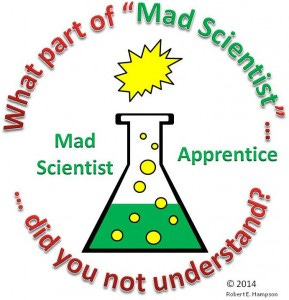Mad Scientist's Apprentice: Math
Sorry, there will be a delay with this week's Eat This While you Read That! because I just ran out of time. I have the photos, but they need edited and the recipes need written out and well it has been crazy here. So! Instead you get an essay I had to write for math class. It is also cross-posted to The Otherwhere Gazette, where it is part of a weekly series named The Mad Scientist's Apprentice and is about my adventures as a non-traditional, female, STEM student.

I have long had a love-hate relationship with math. I appreciate the elegance of working a difficult problem, watching it snap into place with unerring logic and the solution revealed. But it's a slow process for me, and arithmetic can be frustrating as I will transpose numbers or forget them as I look from chalkboard to paper to write them down. Add to this, it has been twenty years since I last encountered math in high school, and when I began college three years ago, I was very uncertain about encountering higher-level math. Calculus, I told everyone who cared, was simply unthinkable for me.
In high school, I had gone through math happily enough, topping out with Plane Trigonometry when I was told that my (very small) school simply didn't have a teacher competent to teach me calculus. It wasn't until I re-entered college that I realized this was going to be a challenge. In my first year, I had to take a test to place in math class, and failed to make a high enough score to be able to take College Algebra. I tried again, and missed by two points. Unwilling to waste time and money on a remedial course, and remembering that I had really enjoyed algebra in high school, I asked for and was granted a waiver. The school, I signed off, would not be responsible for my grade. I was on my own. Then again, I was always on my own when it came to grades, so I dove into the class and found that although I was rusty, it did come back. I got an A- in the class.
Fast forward a year to my next encounter, with Pre-calculus. I was worried about it, knowing that I had never encountered it in my younger years, and I certainly had not gotten any faster with my math skills. When I began the class, I knew from the beginning I would have a problem. The instructor would face the board, working very quickly, and talking to the board rather than the class. I would speed through note-taking, looking at them after class with a sinking heart, because they just didn't make logical sense. I found the Math Lab, a peer tutor, classmates, and especially Khan Academy, a great help. Although I would fail most of my exams, due to the short time allowed to take them, I was able to make a perfect grade on my homework and that made all the difference. I thought I was done with math. Surely I couldn't cope with Calculus, and it was not required for my primary major.
I sat down with my Forensic degree advisor and as we were talking about my struggles with pre-calculus, she pointed out that although Calculus was not required for my degree, it was a requirement if I planned to seek certification as a Forensic Scientist. I took a deep breath, and scheduled the course. Calculus does have immediate and obvious applications in my planned career. When it comes to infectious disease (my secondary major is in Microbiology) it is used to create models both predicting an epidemic's growth curve, but also to plot where it came from. Calculus-based statistics offers the ability to take a curved-line scatterplot, such as would be produced by a quantity over time exhibiting exponential growth or decay, and understanding the data at a deeper, more precise level than afforded by College algebra. This is then applied to the growth of microbes for a clearer understanding, and prediction of, populations under given conditions. Further, genetic recombination, a common occurrence in bacteria, can be difficult to follow and predict without using the ideas of non-linear transformation. Life seldom proceeds in neat, straight lines.
In Forensics, it can be used to create computer models that can piece together the patterns of blood spatter, or gunshots. It can be used to create statistical models that will allow a pattern of crime to be detected, predicted, and ultimately stopped through the application of force in crucial places. Calculus can be used to assist with the delicate and vital determination of time of death, factoring in many variables in a complex process. In short, I will likely be using calculus constantly in my career, even if it is hidden in a computer program. This means that learning how it works is vital rather than relying on it to magically work when I plug in data to a machine. Without the ability to check, the results are worthless.
After the first two weeks of class, I am greatly reassured about taking this course in Calculus. What we have been looking at makes logical sense, and I can wrap my head around it, rather than simply plugging numbers into equations. I have found it to be an interesting and beautiful process, and although I am certain it will be more difficult by the end of the class, and I may still do badly in exams that can be no longer than an hour, I can at least be confident that I will be able to keep up on the homework and learn, really learn, which is the important part of taking this class. I want to be able to practically apply math to my future, and that is more possible with every lesson I learn.



